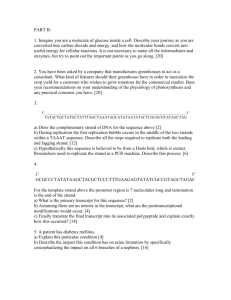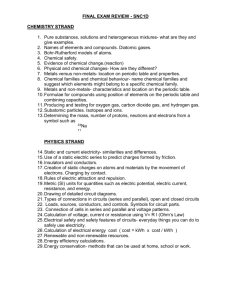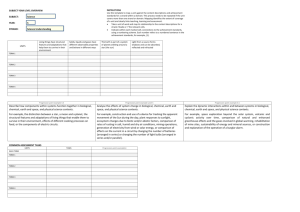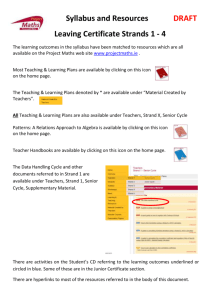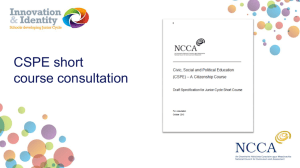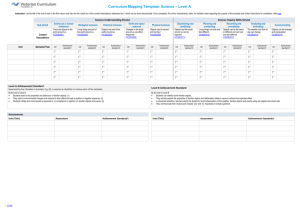Model Medium-Term Plan for Small Schools (Mixed-Age
advertisement
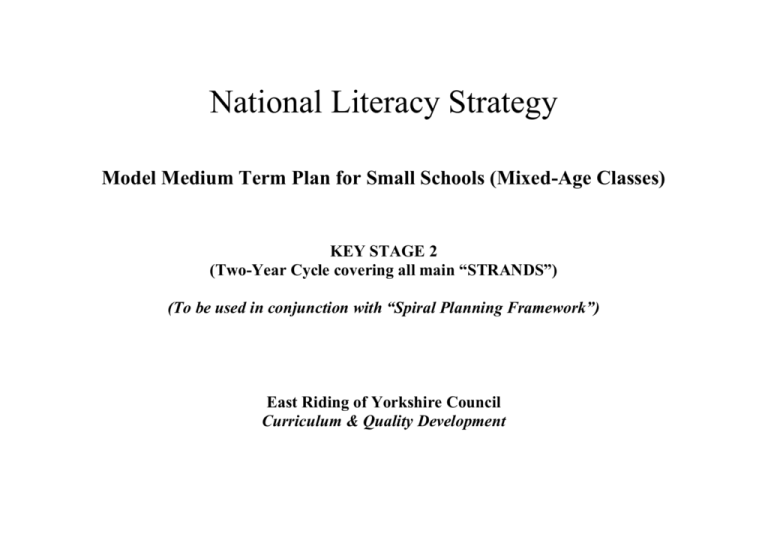
National Literacy Strategy Model Medium Term Plan for Small Schools (Mixed-Age Classes) KEY STAGE 2 (Two-Year Cycle covering all main “STRANDS”) (To be used in conjunction with “Spiral Planning Framework”) East Riding of Yorkshire Council Curriculum & Quality Development SPIRAL STRANDS WORD LEVEL: SENTENCE LEVEL: TEXT LEVEL: FICTION/POETRY TEXT LEVEL: NON-FICTION Ongoing: Spelling Strategies; FR Handwriting; FR Blocked: Spelling Rules and Conventions; FR Vocabulary Extension; FR Ongoing: Grammatical Awareness; 33 Writing Conventions; 42 Audience/Purpose; 42 Blocked: Pluralisation; 34 Adjectives; 34 Verbs; 35 Adverbs; 36 Nouns; 36 Pronouns; 36 Connectives; 37 Prepositions; 37 General Punctuation; 37 Commas; 38 Punctuating Speech; 38 Apostrophes; 39 Sentence Structure; 40 Textual Devices; 41 Ongoing: Generic Reading/Writing Objectives; 3 Blocked: Story Settings; 5 Characters; 6 Story Viewpoint; 7 Story Structure; 8 Story Openings; 9 Expressive Language; 9 Dialogue in Stories; 10 Traditional Stories; 10 Stories from Other Cultures; 11 “Classical” Literature; 12 Extended Story Writing; 12 Story Planning; 13 Playscripts/TV Versions; 14 Poetry; 15 Word Play; 17 Performance Poetry; 18 Ongoing: Generic Objectives (terminology); 19 Generic Objectives (stylestructure); 19 IT texts; 32 Blocked: Gathering Information; 20 Recount Texts; 22 Non-chronological Reports; 23 Instructional/Procedural Texts; 24 Explanation Texts; 25 Discussion/Argument; 26 Persuasive Writing; 27 Newspaper Reporting; 28 Letters; 29 Biography/ Autobiography; 29 Summarising; 30 Note-Taking; 31 STRANDS for ONGOING DEVELOPMENT The Objectives contained in the following strands need to be pursued on an ongoing basis: Word Level: Independent Spelling Strategies Handwriting (probably pursued in a regular, dedicated teaching session outside the “literacy hour”, as well as practised generally) Sentence Level: Grammatical Awareness Writing Conventions Audience/Purpose Text Level (F/P): Generic Reading/Writing Objectives (These can be pursued through regular independent and guided reading sessions - possibly outside the “literacy hour” - especially if these are supported by regular teacher/pupil discussions and the keeping of pupil “reading journals”.) Text Level (N-F): Generic Objectives (terminology) Generic Objectives (style/structure) IT Texts Blocked Strands: First Year : Autumn Term UNIT 1: texts: Selection of short stories with contrasting settings. text strand: Story Settings (F) strand: General Punctuation UNIT 2 : word strand: Spelling Rules sentence texts: Alphabetical texts; directories, encyclopaedia, etc. text strand: Gathering Information (N-F) strand: Textual Devices word strand: Vocabulary sentence UNIT 3: texts: Adventure/Mystery Story (Could be by “significant” writer) text strand: Characters (F) Nouns, Adjectives word strand: Spelling Rules sentence strands: UNIT 4: texts: Examples of recount texts; diaries, letters, school journey reports, etc. text strand: strand: Verbs Recount Texts (N-F) word strand: Vocabulary sentence UNIT 5: texts: Story(ies) about imagined world(s) (Could be by “significant” writer) text strand: Dialogue in Stories (F) strand: Punctuating Speech word strand: Spelling Rules sentence UNIT 6: texts: Playscript (Could be Christmas story - or related theme) text strand: Playscripts (F) word strand: Vocabulary Punctuating Speech sentence strand: Blocked Strands : First Year : Spring Term UNIT 1: texts: Examples of instruction/procedural texts; recipes, manuals, directions, etc. text strand: Procedure Texts (N-F) strand: Prepositions UNIT 2: word strand: Spelling Rules sentence texts: Range of Folk/Fairy Tales text strand: Traditional Stories (F) Sentence Structure word strand: Vocabulary sentence strand: UNIT 3: texts: Versions of same story from different viewpoints (Could be a traditional tale, following on from Unit 2) text strand: Story Viewpoint (F) sentence strand: Pronouns word strand: Spelling Rules UNIT 4: texts: Examples of letters (Could be a story told in letters, and/or could follow on from Unit 3) text strand: Letters (N-F) General Punctuation word strand: Vocabulary sentence strand: UNIT 5: texts: Information texts on similar theme/topic (subject of interest to pupils and/or link with another curriculum area) text strand: Note-Taking (N-F) sentence strand: Pluralisation word strand: Spelling Rules UNIT 6: texts: Poetry which plays with language; word puzzles, puns, riddles, shape poems, etc. text strand: Word Play (P) word strand: Vocabulary sentence strand: Adverbs N.B. Much of this term’s work could be linked to “Traditional Tales” if required. Blocked Strands : First Year : Summer Term UNIT 1: texts: Range of poems on a similar theme (different forms/periods) text strand: Poetry (P) Sentence Structure UNIT 2 : word strand: Spelling Rules sentence strand: texts: Selection of examples of report text-type (Could link to History or Geography) text strand: Non-chronological Reports (N-F) strand: Connectives word strand: Vocabulary sentence UNIT 3: texts: Range of short stories with interesting structures (Could be - stories raising issues; myths/legends; by “significant” authors) text strand: Story Structure (F) strand: Sentence Structure word strand: Spelling Rules sentence UNIT 4: texts: Continuing from Unit 3 text strand: Commas Story Planning (F) word strand: Vocabulary sentence strand: UNIT 5: texts: Continuing from Units 3 / 4 text strand: Extended Story (F) strand: Punctuating Speech word strand: Spelling Rules sentence UNIT 6: texts: Range of poems suitable for performance (including narrative poems) (Could be by “significant” poet) text strand: Performance Poetry (P) Sentence Structure word strand: Vocabulary sentence strand: N.B. Several sections of this term’s work could all relate to one book, if required (Units 3/4/5 - half a term ??) Blocked Strands : Second Year : Autumn Term UNIT 1: texts: Range of poems by same (“significant”) writer text strand: Poetry (P) Nouns, Adjectives UNIT 2: word strand: Spelling Rules sentence strand: texts: Prose examples of expressive language (following on from Unit 1) text strand: Expressive Language (F/P) strand: Adverbs word strand: Vocabulary sentence UNIT 3: texts: Variety of information texts (Could be linked to history/geography, if required) text strand: Summarising (N-F) strand: Apostrophes word strand: Spelling Rules sentence UNIT 4: texts: Examples on newspaper reports (Could be “Ancient Egyptian News”, etc., if required) text strand: strand: Verbs Newspaper Reporting (N-F) word strand: Vocabulary sentence UNIT 5: texts: Selection of multi-cultural stories (or could be one “other culture”, if required) text strand: Stories Other Cultures (F) sentence strand: Sentence Structure word strand: Spelling Rules UNIT 6: texts: Story to turn into playscript (Could be one used in Unit 5, or could be Christmas related) text strand: Playscripts (F) Punctuating Speech word strand: Vocabulary N.B. This whole term could have “other cultures” theme if required. sentence strand: Blocked Strands : Second Year : Spring Term UNIT 1: texts: Information text(s) related to topic(s) from other curriculum area(s) text strand: Gathering Information (N-F) sentence strand: Textual Devices word strand: Spelling Rules UNIT 2: texts: Explanation texts (Could relate to Unit 1) text strand: Connectives Explanation Texts (N-F) word strand: Vocabulary sentence strand: UNIT 3: texts: Range of varied story openings (Could relate to stories with historical settings) text strand: Story Openings (F) strand: Sentence Structure word strand: Spelling Rules sentence UNIT 4: texts: Range of biographical/autobiographical texts (Could relate to Unit 3) text strand: Pronouns Biography/Auto (N-F) word strand: Vocabulary sentence strand: UNIT 5: texts: Texts to provide models for story planning (Could relate to Units 3/4) text strand: Story Planning (F) strand: General Punctuation word strand: Spelling Rules sentence UNIT 6: texts: Extended from Units 3 and/or 4 and/or 5 text strand: Extended Story Writing (F) strand: Sentence Structure word strand: Vocabulary N.B. This whole term could have a strong history link, if required. sentence Blocked Strands : Second Year : Summer Term UNIT 1: texts: Example(s) of “classic” text(s) (Could be Shakespeare or others) text strand: “Classical” Literature (F) sentence strand: Sentence Structure word strand: Spelling Rules UNIT 2: texts: Texts to exemplify structural forms (Could be versions of “classic” stories) text strand: Commas Story Structure (F) word strand: Vocabulary sentence strand: UNIT 3: texts: Stories/extracts with examples of dialogue (Could relate to Units 1/2) text strand: Dialogue in Stories (F) strand: Punctuating Speech word strand: Spelling Rules sentence UNIT 4: texts: Examples of letters (Could relate to above. Macbeth ? Twelfth Night ? Could be letters from/to fictional/historical characters) text strand: Punctuation Letters (N-F) word strand: Vocabulary sentence strand: General UNIT 5: texts: Examples of discussion/argument in writing text strand: Discussion/Argument (N-F) sentence strand: Pluralisation word strand: Spelling Rules UNIT 6: texts: Examples of persuasive writing; adverts, pamphlets, etc. text strand: Persuasive Writing (N-F) strand: Prepositions word strand: Vocabulary sentence N.B. Much of this term could relate to study of a particular “classic” text, if required. Notes on “Blocked” Strands : Two-Year Cycle The two years of the cycle, and the terms within them, are interchangeable. It is the objectives WITHIN each STRAND which are developmental, not the strands themselves. However, pupils will not have covered all strands until they have completed both years of the cycle. Each Unit is envisaged as TWO WEEKS of “Literacy Hours”, with additional time outside this to extend the writing activities. (Plus handwriting, plus daily independent/guided reading ??) Each Unit is intended to cover both reading and writing objectives. The WORD level strand could be pursued one week of the two, SENTENCE level the other. Alternatively the two could be intermingled over the two weeks if preferred. The full range of WORD/SENTENCE level strands are covered in EACH year of the cycle, so that pupils will benefit from regular “spiral” revisiting. Some strands with many learning objectives (e.g. “Sentence Structure”) are revisited a number of times per year. There are SIX units per term, but these could be moved, expanded or contracted to fit the available time. Units could be delivered in any order (although sometimes a “flow” or sequence of work extends over two or three units). In whole Key Stage 2 classes, at each visit to a particular “strand” the teacher will need to try to cover all or most of the range of different objectives associated with it (see “Spiral Framework”). These objectives could be arranged into three broad ability “bands” to help render planning and delivery practicable. When repeating the cycle, individual pupils should be able to move on to “higher” objectives within each strand. There is considerable flexibility as to the particular texts to be used for each unit. Hence when revisiting a unit, the work could be made to feel very different each time, from the pupils’ point of view. (i.e. By using totally different texts, the full two-year cycle could be repeated in a whole-Key-StageTwo class without the pupils feeling they were doing the same thing over again.) In a Y3/Y4 class it would be possible to work the two-year cycle, largely ignoring the Y5/Y6 objectives in each strand. A Y5/Y6 class could then repeat the cycle (with totally different texts), working mainly from the Y5/Y6 objectives in each strand.



